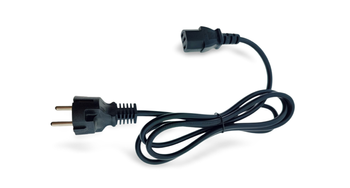DC and AC cables: A comprehensive guide and online shop

DC cable - an underestimated component of a power supply
Every power supply unit has a cable at its output to supply power to the load, which means that few people consider what characteristics this cable should have in order to maintain high performance and power quality. As a result, the DC cable often wrongly becomes an element overlooked in design considerations.
Firstly, the DC cable must ensure that there is a low voltage drop between the output of the power supply and the connector at its end. Thin current-carrying copper conductors cause a large voltage drop under load and noticeable heating of the cables. As a result, the accuracy of voltage stabilisation decreases and the operation of voltage-sensitive devices may be affected. The lower the output voltage and the higher the output current of the power supply, the greater the importance of the cross-section of the copper conductors, which should then be larger. A thick cable does not necessarily mean that the copper conductors in it are of the correct cross-section. Unfortunately, in cheap power supplies, thin wires are hidden in the thick and solid insulation! Secondly, the cable must be flexible in order to fit comfortably in installations, furniture troughs and to be clipped and tidied. Thick and rigid cable is a hindrance especially at low temperatures, when cheap plastics harden noticeably. Stiff cables are more prone to mechanical damage. Thirdly, the cable must be mechanically resistant to damage, i.e. have abrasion-resistant, mechanically robust insulation so that being run over by a wheel from an office chair does not cause a short circuit. There must be bend dampers (benders) at the jack plug and housing.
Our offer: https://zasilacze.online/eng_m_DC-Cables-159.html
AC cable - convenience and safety matters
Mains cables (AC) for switching power supplies have two or three wires and their purpose is to connect to the mains. Power supplies with reinforced insulation are connected with a 2-wire cable, standard versions have a 3-wire cable. The type of plug in the power supply and on the other side of the cable depends on the country of destination and the design of the power supply. There are a total of 12 mains plugs in circulation that can be found in power supply housings, and there are similarly many mains plugs. It follows that the AC mains cable must have a plug that matches the standard of the country and the socket on the power supply. The internal construction of the cable and the cross-sections of the wires must meet the requirements of the safety standards, and the same applies to the thickness of the insulation. The requirements written in the standards are quite strict and as a rule AC cables are quite thick and stiff, especially the 3-wire ones. Hence, it is crucial for the user to choose a manufacturer that uses ductile plastics with added silicones, as these make even thick AC cables soft and safe.
Our offer: https://zasilacze.online/eng_m_AC-Cables-158.html




